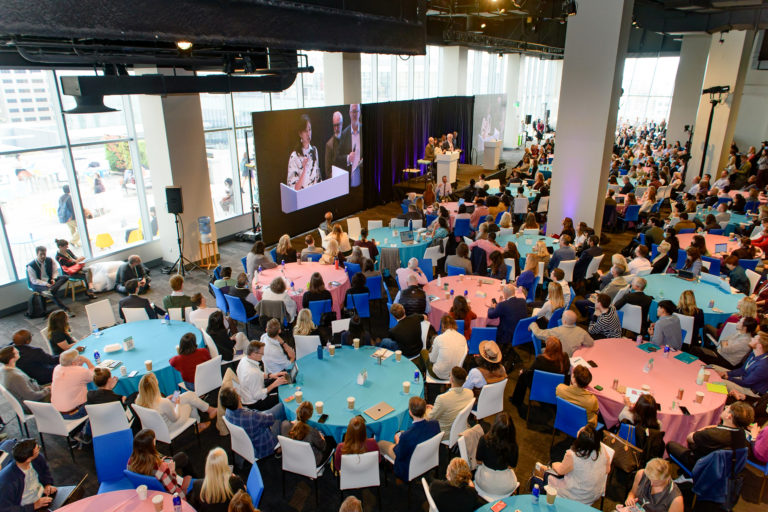Reflections on Impact Investing: A Journey Through SOCAP 2023


Melina Harris, PAGE Impact Analyst and Capital Coordinator
This October, I took advantage of an amazing opportunity, supported by the Economy League and ImpactPHL, to travel to the Social Capital Global Conference (SOCAP) in San Francisco. Each year, SOCAP convenes a global impact investment audience to accelerate the movement towards a more just and sustainable economy through experiences that drive investments in positive impact. Attending SOCAP proved to be a transformative experience, offering a deep dive into a range of themes that underscore the evolving landscape of impact investing. The conference emphasized the collaboration and shared commitment – not merely technological innovation – that is needed to build a more equitable and sustainable future. I’m excited to share my learnings from SOCAP and how they relate to our work at the Economy League.

So first, what is ‘Impact Investing’? Impact investing represents a spectrum of capital deployment that can range from negative screening (e.g. avoiding investments in companies that promote tobacco use or engage in child slavery) to making investments that optimize social and environmental outcomes regardless of a financial tradeoff. While this spectrum is vast and complex, most impact investments are characterized by their focus on measurable outcomes and an intentionality to address a particular environmental or social concern. They can take the form of various asset classes including private equity, debt, venture capital, and fixed income securities. As with conventional investments, impact investments come with a range of risk-return profiles, but it’s important to note that investing with your values does not always involve concessionary returns. In fact, impact funds have been shown to outperform traditional investment strategies in some cases.
At the conference, I heavily focused on two of the seven content tracks. The first was "Philanthropy as Catalytic Capital," which emphasized the role of philanthropy in catalyzing flows to impact investment and innovative finance. It challenged the conventional notion of philanthropy as a mere source of funding, encouraging a mindset shift towards viewing it as a mechanism to unlock new sources of capital to create positive and systemic change. We learned that by using relatively small amounts of philanthropic capital, we can mitigate the financial risk of investments that provide social goods so that they “have the potential to become commercially viable over time.” The discussions highlighted the need for collaboration along the entire capital continuum, breaking down artificial barriers between impact investing and philanthropy.
The second track I focused on was "Full Spectrum DEI," which tackled the historic lack of diversity, equity, and inclusion across the impact spectrum and called for a focus on wealth and ownership in addressing historical inequity. Practitioners advocated for a comprehensive approach to DEI to inform more equitable investment decisions. The track critically examined evolving language, standards, and measurement of DEI among impact investors, showcasing creative ways to align traditional capital allocation norms with emerging DEI best practices.
These two tracks perfectly complemented each other, challenging us not only to question incumbent values about the purpose of investment, but also to develop actionable strategies that leverage the capital markets to address historical inequities. Most importantly, the conversation between these two tracks highlighted how economic inequities, created both intentionally and unintentionally, have produced and reproduced the need for philanthropic funding models to begin with and asked donors to consider philanthropy as an act of asset transfer (rather than benevolent generosity) to achieve lasting impact for racial justice and gender equity.
At PAGE, we have also talked about importance of collaboration across the capital spectrum in addressing the racial wealth gap. This kind of approach, also known as ‘blended capital’ or ‘blended finance’ occurs when public or philanthropic funds are combined with private capital to address global challenges more effectively. Recently in Philadelphia, for example, the initial investment of city funds into our waterfront has spurred the movement of millions of dollars in private and state capital to develop a menagerie of parks, venues, and markets along the Delaware River. In racial justice investing, a blended finance strategy could include providing low-cost capital to CDFIs to invest in Black and Brown-owned businesses alongside an infusion of philanthropic dollars to allow the CDFI to provide wrap-around support to those borrowers. The purpose of a dual investment like this would be to enhance both the opportunities for and viability of these businesses, therefore mitigating the risk that these loans will not be repaid. These two forms of capital could come from within the same portfolio, or from two different asset holders with different investment criteria and a shared commitment to racial justice.
Not only do I believe that blended capital models are a logistically critical piece of the strategy needed to close the racial wealth divide, but I also insist that righting the history of economic racism, disinvestment and theft carried out through a plethora of capital flows (home mortgages, federal funding, private debt, corporate wages, venture capital, etc.), demands that we deploy that very same spectrum in addressing the conditions that exist for Black and Brown business owners today. This is precisely why we are so proud of the PAGE Hurdle Fund, which not only uses philanthropic dollars to transfer assets to Black and Brown business owners, but does so by ‘investing’ these dollars into businesses poised to take advantage of an opportunity that will grow their revenue, grow jobs, and generally add value to our communities. These small grants not only unlock contracts and revenue for these businesses, but they also mitigate risk for future lenders and investors who may later provide growth capital to the firm. In this way, Hurdle Fund grants catalyze impact beyond the value of the particular piece of equipment, certification, or insurance they provide.
I am grateful to say that my experience in San Francisco demonstrated that there is global concern for the issues raised above and renewed my hope that, together, we can drive positive impact for diverse entrepreneurs in Philadelphia. As I reflect on SOCAP 2023, the two biggest takeaways I brought back to Philadelphia were that 1) ‘market rate’ returns vary in different contexts and that 2) people, not products are the solution.
I began this article by explaining that ‘impact investment’ is a broad term that can encompass a range of risk and return opportunities for the asset holder. But the philosophy of impact investment generally challenges the notion that investment should place financial return over justice and the well-being of people and planet. Moreover, given that the financial sector has been subsidized by hundreds of years of climate degradation and slavery, ‘market rate’ may mean something very different today than it did yesterday. And getting a 1% return on an ‘investment’ that is attempting (or not) to address the harm that was caused in building that wealth in the first place, may very well be an outsized financial return.
Finally, it is imperative to acknowledge that addressing the multifaceted global crises of our time—ranging from climate issues to poverty and safety concerns—requires fostering inclusive participation towards crafting solutions. Historically, Indigenous communities have demonstrated effective approaches in combating climate change, yet their invaluable insights have often been overlooked. Black Americans are more likely to start businesses than any other ethnic group, significantly contributing to economic growth and job creation, and yet there persists a pattern of insufficient investment in diverse founders, coupled with a failure to remedy systemic biases in funding assessments. Prioritizing investments in the individuals who know how to serve their communities best because they are from those communities remains indispensable. However, we will continue to face substantial hurdles in allocating capital equitably and strategically so long as the folks who created and/or benefit from this system continue to retain decision-making power. As one conference-goer said, “who we invest in or who makes the investment decision and how we make that decision is at least as important as what we invest in, if not more.”